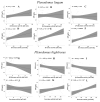Differences in the Production of Extracellular Polymeric Substances (EPS) and Other Metabolites of Plenodomus (Leptosphaeria) Infecting Winter Oilseed Rape (Brassica napus L.)
- PMID: 37367918
- PMCID: PMC10302272
- DOI: 10.3390/metabo13060759
Differences in the Production of Extracellular Polymeric Substances (EPS) and Other Metabolites of Plenodomus (Leptosphaeria) Infecting Winter Oilseed Rape (Brassica napus L.)
Abstract
Species of the genus Plenodomus (Leptosphaeria) are phytopathogens of the Brassicaceae family, which includes oilseed rape. The spores of these fungi spread by airborne transmission, infect plants, and cause crop losses. The secondary metabolism of P. lingam and P. biglobosus was studied and compared, with the main focus being on the ability to produce Extracellular Polymeric Substances (EPS). In spite of the 1.5-2-fold faster growth rate of P. biglobosus on Czapek-Dox and other screening media, the average yield of EPS in this fungus was only 0.29 g/L, compared to that of P. lingam (0.43 g/L). In turn, P. biglobosus showed a higher capacity to synthesise IAA, i.e., 14 µg/mL, in contrast to <1.5 µg/mL produced by P. lingam. On the other hand, the P. lingam strains showed higher β-glucanase activity (350-400 mU/mL), compared to 50-100 mU/mL in P. biglobosus. Invertase levels were similar in both species (250 mU/mL). The positive correlation between invertase activity and EPS yield contrasted with the absence of a correlation of EPS with β-glucanase. Plenodomus neither solubilised phosphate nor used proteins from milk. All strains showed the ability to synthesise siderophores on CAS agar. P. biglobosus exhibited the highest efficiency of amylolytic and cellulolytic activity.
Keywords: IAA; Plenodomus (Leptosphaeria); enzyme activity; exopolysaccharide; extracellular polymeric substance (EPS); invertase; siderophore; winter oilseed rape; β-glucanase.
Conflict of interest statement
The authors declare no conflict of interest.
Figures










Similar articles
-
Metabolic Capacity Differentiates Plenodomus lingam from P. biglobosus Subclade 'brassicae', the Causal Agents of Phoma Leaf Spotting and Stem Canker of Oilseed Rape (Brassica napus) in Agricultural Ecosystems.Pathogens. 2022 Jan 1;11(1):50. doi: 10.3390/pathogens11010050. Pathogens. 2022. PMID: 35055998 Free PMC article.
-
Efficient qPCR estimation and discrimination of airborne inoculum of Leptosphaeria maculans and L. biglobosa, the causal organisms of phoma leaf spotting and stem canker of oilseed rape.Pest Manag Sci. 2024 May;80(5):2453-2460. doi: 10.1002/ps.7800. Epub 2023 Dec 6. Pest Manag Sci. 2024. PMID: 37759372
-
Indirect Evidence Based on Mating-Type Ratios for the Role of Sexual Reproduction in European and Chinese Populations of Plenodomus biglobosus (Blackleg of Oilseed Rape).Pathogens. 2022 Dec 20;12(1):3. doi: 10.3390/pathogens12010003. Pathogens. 2022. PMID: 36678351 Free PMC article.
-
Molecular Interactions Between Leptosphaeria maculans and Brassica Species.Annu Rev Phytopathol. 2022 Aug 26;60:237-257. doi: 10.1146/annurev-phyto-021621-120602. Epub 2022 May 16. Annu Rev Phytopathol. 2022. PMID: 35576591 Review.
-
[Gene flow and its ecological risks of transgenic oilseed rape ( Brassica napus)].Ying Yong Sheng Tai Xue Bao. 2005 Dec;16(12):2465-8. Ying Yong Sheng Tai Xue Bao. 2005. PMID: 16515208 Review. Chinese.
Cited by
-
Feels Like Home: A Biobased and Biodegradable Plastic Offers a Novel Habitat for Diverse Plant Pathogenic Fungi in Temperate Forest Ecosystems.Microb Ecol. 2024 Dec 21;87(1):155. doi: 10.1007/s00248-024-02466-0. Microb Ecol. 2024. PMID: 39708062 Free PMC article.
References
-
- Kessler A., Kalske A. Plant secondary metabolite diversity and species interactions. Annu. Rev. Ecol. Evol. Syst. 2018;49:115–138. doi: 10.1146/annurev-ecolsys-110617-062406. - DOI
LinkOut - more resources
Full Text Sources
Research Materials

